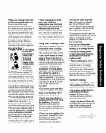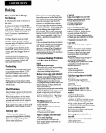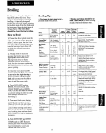
Surface Cooking
Automatic Ignition
Your surface burners are lighted
by electric ignition, eliminating the
need for standing pilot lights with
constantly burning flames.
In case of a power outage, you can
light the surface burners on your
range with a match. Hold a lighted
match to the burner, then turn the
knob to the LITE position. Use
extreme caution when lighting
burners this way.
Surface burners in use when an
electrical power failure occurs will
continue to operate normally.
Surface Burner Controls
Knobs that turn the surface burners
on and off are located on the lower
control panel and are marked as to
which burners they control.
To Light a Surface Burner
Push the control knob in and turn
it to LITE. You will hear a little
clicking noise-the sound of the
electric spark igniting the burner.
After the burner ignites, turn the
knob to adjust the flame size.
l
Check to be sure the burner you
turned on is the one you want to use.
l
Do not operate a burner for an
extended period of time without
cookware on the grate. The finish
on the grate may chip without
cookware to absorb the heat.
l
Be sure the burners and grates are
cool before you place your hand, a
potholder, cleaning cloths or other
materials on them.
How to Select Flame Size
The flame size on a gas burner
should match the cookware you
are using.
NEVER LET THE FLAME
EXTEND UP THE SIDES OF
THE COOKWARE. Any flame
larger than the bottom of the
cookware is wasted and only serves
to heat the handles.
When using aluminum or
aluminum-clad stainless steel
pots and pans, adjust the flame so
the circle it makes is about l/2 inch
smaller than the bottom of the
cookware.
When boiling, use this same flame
size-l/2 inch smaller than the
bottom of the cookware-no matter
what the cookware is made of. Foods
cook just as quickly at a gentle boil
as they do at a furious rolling boil.
A high boil creates steam and cooks
away moisture, flavor and nutrition.
Avoid it except for the few cooking
processes which need a vigorous boil.
When frying or warming foods
in stainless steel, cast iron or
enamelware, keep the flame down
lower-to about l/2 the diameter
of the pan.
When frying in glass or ceramic
cookware, lower the flame even more.
Cooktop Light
A full-width fluorescent light in the
backsplash illuminates the cooktop.
Press and momentarily hold the
SURFACE LIGHT switch under
the upper control panel to turn
the light on and off.
Top-of-Range Cookware
Aluminum: Medium-weight
cookware is recommended because it
heats quickly and evenly. Most foods
brown evenly in an aluminum skillet.
Minerals in food and water will stain
but will not harm aluminum. A
quick scour with a soap-filled wool
pad after each use keeps aluminum
cookware looking shiny new. Use
saucepans with tight-fitting lids for
cooking with minimum amounts
of water.
Cast Iron: If heated slowly, most
skillets will give satisfactory results.
Enamelware: Under some
conditions, the enamel of some
cookware may melt. Follow cookware
manufacturer’s recommendations
for cooking methods.
Glass: There are two types of glass
cookware-those for oven use only
and those for top-of-range cooking
(saucepans, coffee and teapots).
Glass conducts heat very slowly.
Heatproof Glass Ceramic: Can
be used for either surface or oven
cooking. It conducts heat very
slowly and cools very slowly.
Check cookware manufacturer’s
directions to be sure it can be used
on gas ranges.
Stainless Steel: This metal alone
has poor heating properties, and is
usually combined with copper,
aluminum or other metals for
improved heat distribution.
Combination metal skillets usually
work satisfactorily if they are
used with medium heat as the
manufacturer recommends.
7


















